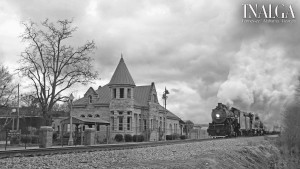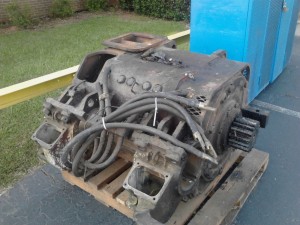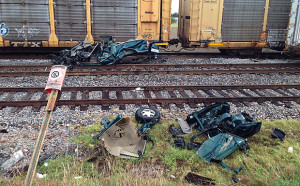This photo of the Fort Payne, Alabama, classic stone Victorian depot (now a museum) is reminiscent of the days of “working steam.” (This is a recent photo of an excursion train; if you enlarge the photo by clicking on it and look closely, you’ll see the “Museum” sign to the left and notice there’s a diesel unit behind the steamer.)
 Diesel power isn’t as romantic as steam, but it saved the railroad industry. Steam locomotives, despite their nostalgic appeal, are dirty, inefficient, expensive to maintain, and spend a lot of downtime in the shops. The pounding of their pistons and rods wears out wheels, rails, and roadbeds. A handful of aging survivors now haul excursion trains, but workaday scenes like this are gone from America forever. Fast passenger trains have been replaced by air travel, and mixed-freight trains by diesel-pulled strings of intermodal flats.
Diesel power isn’t as romantic as steam, but it saved the railroad industry. Steam locomotives, despite their nostalgic appeal, are dirty, inefficient, expensive to maintain, and spend a lot of downtime in the shops. The pounding of their pistons and rods wears out wheels, rails, and roadbeds. A handful of aging survivors now haul excursion trains, but workaday scenes like this are gone from America forever. Fast passenger trains have been replaced by air travel, and mixed-freight trains by diesel-pulled strings of intermodal flats.
 The diesel engine has been around since before automobiles. But it wasn’t extensively adopted for railroad use until the 1950s because gearing an internal combustion engine directly to a locomotive’s drive wheels isn’t practical. This problem was solved by converting the diesel engine’s output into electricity that powers electric motors that turn the drive wheels. An electric motor has enormous torque even at zero RPM, which is what you need to get a train weighing thousands of tons to start moving from a standing stop.
The diesel engine has been around since before automobiles. But it wasn’t extensively adopted for railroad use until the 1950s because gearing an internal combustion engine directly to a locomotive’s drive wheels isn’t practical. This problem was solved by converting the diesel engine’s output into electricity that powers electric motors that turn the drive wheels. An electric motor has enormous torque even at zero RPM, which is what you need to get a train weighing thousands of tons to start moving from a standing stop.
Once the train reaches road speed, it doesn’t need energy to keep it going. Just don’t expect it to quickly if you decide to run the crossing in your car.
